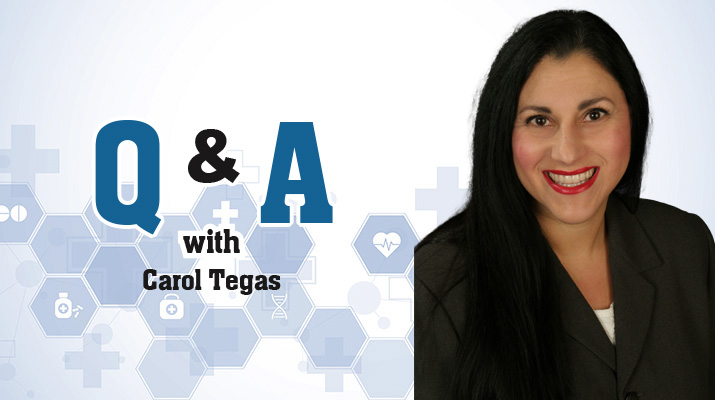Executive director of the Finger Lakes Performing Provider System discusses the agency’s mission and how it’s working with local providers to train new home health aides
By Mike Costanza
Since 2014, the Finger Lakes Performing Provider System has striven to improve the healthcare delivery systems that serve a 13-county region of Upstate New York.
The Rochester-based nonprofit partners with health and human service providers throughout the region in order to accomplish that goal, including health care systems, behavioral health providers, federally qualified health centers and community-based organizations. It has just 38 employees and a budget of about $25 million.
In Good Health spoke to Carol Tegas, the executive director of the Finger Lakes Performing Provider System, about the nonprofit’s goals, accomplishments and challenges.
Q: What is the Finger Lakes Performing Provider System?
A: We were started in 2014 for the express purpose of implementing the New York State Delivery System Reform Incentive Payment Program. The original purpose of the organization was to implement that program over the five years for the purpose of transforming the Medicaid health care delivery system. The very, very high-level goal was to reduce avoidable hospitalizations. We improved clinical outcomes and achieved 99% of all project milestones.
Q: Can you tell us of one of FLPPS’s goals?
A: We successfully implemented a maternal child health program where we paired pregnant moms early on with community health workers to make sure that they are getting those prenatal visits in, and so we can lower the rates of low birth weights. We also improved health outcomes.
Q: What are FLPPS’s current aims?
A: The [DSRIP] program ended in 2020. What we have done since then is continue that work. Now, it’s really about community and clinical integration, really connecting the healthcare sector with the social care sector for services like transportation, housing, nutrition, innovative community-based programming. Addressing those things that impact people’s lives that are not specifically clinical or health care; but rather the things that are going on in your life.
Q: Could you give the readers an example of what FLPPS is trying to do?
A: For pregnant moms, to make sure they’re eating healthy food; that they’re getting their regular checkups. [It] is really trying to address what’s called the social determinants of health, especially in the more vulnerable population — that’s the Medicaid population. That’s the next evolution of health care.
Q: Has FLPPS tackled other important issues?
A: The struggles that the health systems, the hospitals have had with a complete backlog of patients in emergency rooms and not being able to move people thorough the system. There are hundreds of people who are waiting to be discharged, but the skilled nursing facilities can’t take them to that next level of care that’s more appropriate, like for rehab or for nursing home care. The skilled nursing facilities lose so much money in the Medicaid reimbursement they don’t have the workforce and they’ve actually had to close beds. They need workforce, they need the physical beds, they need better payments for all the overhead.
Q: How has FLPPS helped the health care systems deal with that problem?
A: We created a program called the Transformational Community Care Coordination Program using ARPA [American Rescue Plan Act] dollars from Monroe County. There were two pieces to the program. The Complex Care Program was designed to partner with the health care system and with skilled nursing facilities and help with providing resources to the skilled nursing facilities so that they could open up beds, have workforce, have the proper equipment so that they could take in what we call difficult-to-place patients. In partner with these skilled nursing facilities and the health systems, we created new workflows, we worked with them to redesign processes, we added funding, and we collected data. We were very successful in moving 545 patients out of the hospital over the course of less than a year.
The second piece of it is the Long-Term Care Workforce Program. That is focusing on providing tuition assistance, wraparound services for people who are going through certified nursing assistant, licensed practical nurse, registered nurse training so that they can come out and have a career pathway.
Q: FLPPS is also collaborating with HCR Home Care, Rochester Regional Health Home Care and UR Medicine Home Care on a training program for home health aides. Can you tell us about that program?
A: One of the greatest barriers to increasing the healthcare workforce is that people need to work while they’re going to school. That is a real difficulty for a lot of people, especially in that kind of lower socioeconomic kind of band. We partnered with home health aide agencies, with other community-based organizations, wherever we could find a cohort of people who might be interested in getting trained to be a home health aide. The program helps them secure a job and provide the training at the same time that they’re working. From a short-term perspective, you’re trying to relieve that backlog. From a long term-perspective you’re really enhancing and improving the workforce in our community, in our city and in our county. The program is financed by ARPA funds from the city of Rochester and funds from the ESL Charitable Foundation.
Q: Has the collaboration been successful so far?
A: We have 75 individuals who have already been hired, trained and are certified as home health aides, and we have 24 who are in training. We’re going through a recruitment campaign now.
Q: What challenges does FLPPS face right now?
A: Workforce on behalf of our partners. If we can start to address the workforce challenges in our healthcare arena, then we can start to really focus on what’s important, which is improving care.

